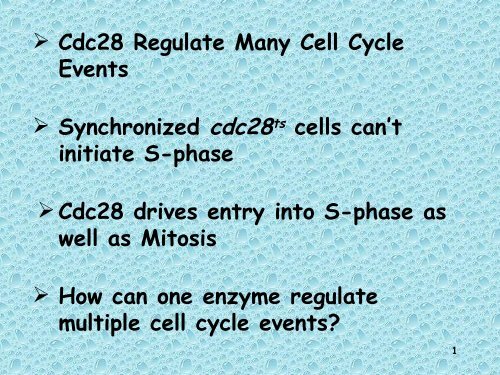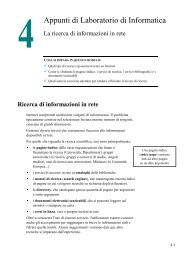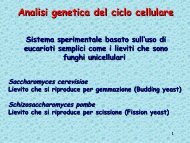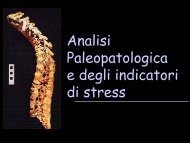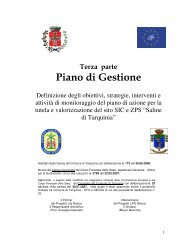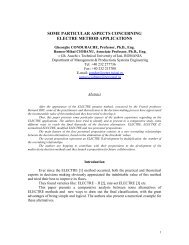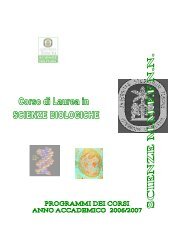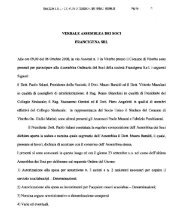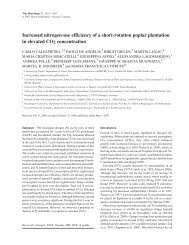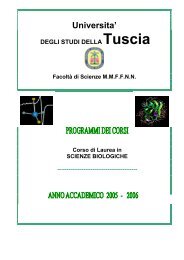RB - Università degli Studi della Tuscia
RB - Università degli Studi della Tuscia
RB - Università degli Studi della Tuscia
Create successful ePaper yourself
Turn your PDF publications into a flip-book with our unique Google optimized e-Paper software.
Cdc28 Regulate Many Cell Cycle<br />
Events<br />
Synchronized cdc28 ts cells can’t<br />
initiate S-phase<br />
Cdc28 drives entry into S-phase as<br />
well as Mitosis<br />
How can one enzyme regulate<br />
multiple cell cycle events?<br />
1
Cells Use Multiple Cyclins to Regulate<br />
Different Cell Cycle Events<br />
Cicline M<br />
Cicline G1<br />
2
Il complesso MPF regola l’ingresso mitotico<br />
(studi su S. S. pombe) pombe<br />
Il complesso MPF è formato da<br />
Cdc28/cicline mitotiche in S. cerevisiae e<br />
Cdc2/Cdc13 in S. pombe<br />
Il complesso SPF regola l’ingresso in S<br />
(studi su S. S. cerevisiae)<br />
cerevisiae<br />
Il complesso SPF è formato da<br />
Cdc28/cicline G1 in S. cerevisiae<br />
3
Modello di azione del complesso Cdc28/cicline<br />
in S. S. cerevisiae<br />
4
Cyclin<br />
G1 Cyclins<br />
Cln1<br />
Cln2<br />
Cln3<br />
B-type Cyclins<br />
Clb1<br />
Clb2<br />
Clb3<br />
Clb4<br />
Clb5<br />
Clb6<br />
Budding Yeast Cyclin Genes<br />
Identification<br />
mutant<br />
mutant<br />
mutant<br />
Homology<br />
Homology<br />
Homology<br />
Homology<br />
Accidental<br />
Accidental<br />
Expression<br />
G1<br />
G1<br />
G1<br />
M<br />
M<br />
S<br />
S<br />
G1<br />
G1<br />
Function<br />
START<br />
START<br />
START<br />
Mitosis<br />
Mitosis<br />
Spindle<br />
Spindle<br />
S-phase entry<br />
S-phase entry<br />
5
Cyclins Nomenclature<br />
All contain “cyclin box” domain cdc2 binding domain<br />
Cyclin A<br />
Cyclin B’s<br />
S. pombe cdc13...<br />
S. cerevisiae CLB1,2,3,4,5,6<br />
G1 Cyclins<br />
S. cerevisiae CLN1,2,3<br />
A and B’s closely related<br />
- destruction box<br />
- required for S and M<br />
- “A” accumulates earlier,<br />
- degraded earlier<br />
- G1’s more similar to each other<br />
-PEST domains (Pro,Glu,SerThr)<br />
6
Cyclins can be grouped by expression patterns<br />
[Cyclin]<br />
- CLN1 and CLN2 and CLB5 and CLB6 -<br />
- CLB3 and CLB4<br />
- CLB 1 and CLB2<br />
CLN1,2,CLB5,6<br />
CLB3,4<br />
CLN3<br />
G1 Start Metaphase<br />
CLB1,2<br />
7
Yeast Cyclin Genes: CLNs and CLBs<br />
Clb3,4<br />
Activate replication<br />
origins<br />
Clb5,6<br />
G1 entry<br />
Triple cln1,2,3 mutant<br />
Quadruple clb1,2 mutant<br />
CLN1,2,3<br />
Sense cell size, commit to division<br />
Dominant CLN Mutations<br />
Clb1,2<br />
Spindle assembly<br />
anaphase
Vertebrate Cells, like budding yeast,<br />
express multiple cyclins, but they<br />
also express several CDK’s<br />
9
Regulation of G1/S transition (start/restriction point)<br />
Identification of mammalian G1 cyclins<br />
Human cDNA libraries screened for ability to complement CLN3 mutant<br />
lead to cloning of three human G1 cyclins:<br />
Cyclin C<br />
Cyclin D1<br />
Cyclin E<br />
Cyclin D2 and Cyclin D3 subsequently<br />
identified<br />
D-type cyclins: respond to growth factors<br />
G 0 to G1 transition<br />
E-type cyclin: expression is periodic<br />
peaks at G1/S transition<br />
controls ability of mammalian cells<br />
to enter S-phase<br />
10
Regulation of G1/S transition (start/restriction point)<br />
Identification of mammalian cyclin-dependent kinases (CDKs)<br />
Human cDNA libraries screened for ability to complement budding yeast<br />
CDC28 mutant<br />
Three cDNA clones identified which could complement CDC28 mutant<br />
Mammalian cdk1 acts at G2/M transition<br />
cdk2 acts at G1/S transition<br />
cdk3 unknown function<br />
Cdk4 identified in an anti-cyclin D coimmunoprecipitation<br />
experiment<br />
Unable to complement CDC28<br />
11
Punti di controllo del ciclo cellulare<br />
START PUNTO DI RESTRIZIONE<br />
Budding yeast Mammiferi<br />
13
Restriction point (START)<br />
Point at which cell is irreversibly<br />
committed to traversing the cell cycle<br />
Mammals: restriction point<br />
Yeast: START<br />
Cell cycle proceeds without influence<br />
from environment (only stopped by<br />
damage)<br />
Late in G 1<br />
14
To divide or not to divide:<br />
that is the question<br />
Yeast cells make decision based on<br />
cell size, which is dependent on<br />
nutrient availability<br />
Mammalian cells make decision based<br />
on the presence of protein growth<br />
factors called mitogens that<br />
stimulate cell growth<br />
15
In assenza di fattori di crescita le<br />
cellule di mammifero si arrestano in<br />
G0 (cellule cellule quiescenti);<br />
quiescenti<br />
L’aggiunta di mitogeni causa il<br />
passaggio attraverso il punto di<br />
restrizione (dopo dopo 14-16 ore); ore<br />
Le cellule in proliferazione entrano in<br />
S (dopo dopo altre 6-8 ore)<br />
ore<br />
16
Cyclin D is required to pass restriction point<br />
R point<br />
Colorazione 16 ore dopo la microiniezione<br />
e l’aggiunta di<br />
BrdU al mezzo.<br />
Colorante per DNA<br />
Anticorpi anti-BrdU<br />
Anticorpi anti-cicl.D<br />
17
Continous expression of Cyclin E shortens G1<br />
18
Attività dei complessi<br />
Cdk/ciclina dei mammiferi<br />
All’inizio <strong>della</strong> fase S le<br />
cicline D ed E vengono<br />
degradate. I livelli di Cdk4<br />
e 6 crollano repentinamente<br />
All’inizio <strong>della</strong> fase S viene<br />
sintetizzata la ciclina A che si<br />
associa a Cdk2. La distruzione <strong>della</strong><br />
ciclina A o una sua modificazione<br />
inibiscono la sintesi di DNA.<br />
Queste proteine non sono<br />
necessarie per la progressione<br />
nella fase S<br />
Il complesso Cdk2/ciclina A è<br />
indispensabile per la<br />
progressione nella fase S<br />
19
Cell-cycle phase-specific<br />
Three classes:<br />
G 1 Cdk complexes<br />
Cdk complexes<br />
S-phase Cdk complexes<br />
Mitotic Cdk complexes (also known as MPF)<br />
Cell-cycle phase specificity determined by<br />
cyclin type and, in some cells, Cdk type<br />
20
Controllo del ciclo cellulare dei mammiferi<br />
Ingresso in fase M (complesso MPF)<br />
Cdk1/ciclina A<br />
Cdk1/ciclina B<br />
Ingresso in fase S (complesso SPF)<br />
Cdk4,6/ciclina D punto di restrizione<br />
Cdk2/ciclina E<br />
Progressione in fase S<br />
Cdk2/ciclina A<br />
ingresso in S<br />
21
In addition to forming complexes between<br />
specific Cdks and their cyclin binding<br />
partners, all complexes require<br />
phosphorylation and dephosphorylation to<br />
become fully active<br />
phosphorylation of thr160/161 is<br />
important for the activation of all major<br />
Cdk/cyclin complexes<br />
catalysed by Cdk activating kinase CAK<br />
22
Regolazione <strong>della</strong> Cdk1 mediante<br />
fosforilazione-defosforilazione<br />
Siti di inattivazione<br />
Sito di attivazione<br />
Equilibrio tra fosfatasi (Cdc25) e kinasi (Wee1)<br />
23
Another mechanism by which<br />
CDKs can<br />
regulate Multiple Transitions<br />
is by using<br />
different CDK inhibitors<br />
(CKI’s)<br />
24
CDK activity is controlled by chemical modification,<br />
cyclin synthesis/proteolysis, and:<br />
CKIs (Cyclin-dependent kinase Inhibitors)<br />
25
CKI’s can be specific for particular CDK<br />
complexes because their binding can depend upon<br />
a specific cyclin<br />
CDK<br />
CKI<br />
T-Loop<br />
Cyclin<br />
26
Sic1<br />
Down-regulation of a CKI can, in turn, be<br />
regulated by a CDK-mediated phosphorylation<br />
because its ubiquitin-dependent proteolysis<br />
can be regulated by its phosphorylation state<br />
Cdc28/Cln1,2<br />
27
We can add another limb to our regulation tree<br />
Wee1 kinases<br />
Cdc25 phosphatases<br />
Kap1 phosphatases<br />
Phosphorylation<br />
Control<br />
Transcriptional<br />
Control<br />
Y15<br />
T160<br />
Ubiquitin-dependent<br />
Proteolytic Control<br />
Cdk-Activating<br />
Kinases (CAK)<br />
Cyclin-dependent Kinase<br />
Inhibitors (CKI’s)<br />
Transcriptional<br />
Control<br />
28
Inibitori delle Cdk<br />
Membri diversi di questa famiglia inibiscono Cdk diverse<br />
Inibitore cellule animali<br />
p15, p16<br />
p21, p27<br />
Inibitore lievito<br />
Far1<br />
P40<br />
Cyclin-Cdk complex<br />
Cdk4/ciclinaD<br />
Cdk6/ciclinaD<br />
Cdk4/ciclinaD<br />
Cdk6/ciclinaD<br />
Cdk2/ciclinaE<br />
Cdk2/ciclinaA<br />
Cdc2/Cln<br />
Cdc2/Clb<br />
29
Meccanismi di controllo dell’attività<br />
dei complessi ciclina/CDK<br />
Concentrazione delle cicline<br />
-livello di sintesi tramite controllo trascrizionale<br />
-proteolisi<br />
-localizzazione cellulare<br />
Fosforilazione delle CDK<br />
Inibitori delle CDK<br />
30
Situazioni biologiche in cui la proliferazione è controllata<br />
Embriogenesi: proliferazione attiva<br />
cicli cellulari brevi<br />
rapida successione di fasi di replicazione (S) e mitosi (M)<br />
crescita "logaritmica".<br />
Differenziamento: graduale attivazione di funzioni specializzate<br />
espansione clonale di cellule che si specializzano.<br />
contemporaneamente il ciclo di divisione viene modulato.<br />
Differenziamento terminale: arresto programmato del ciclo (GO).<br />
Reversibilità: cellule differenziate possono ripristinare il programma di<br />
divisione in risposta a stimoli (danni meccanici, agenti fisici etc.).<br />
Proliferazione neoplastica: innesco <strong>della</strong> proliferazione in assenza di<br />
programma, per mutazione di un gene cellulare o infezione di virus<br />
31
2 principali livelli di controllo <strong>della</strong> proliferazione di cellule eucariotiche:<br />
controllo <strong>della</strong> scelta tra destino proliferativo / entrata in quiescenza<br />
(G0) ed eventuale differenziamento <strong>della</strong> cellula.<br />
REGOLATO DALL’ ESTERN0<br />
controllo delle fasi del ciclo e coordinamento tra i diversi eventi necessari<br />
alla divisione cellulare.<br />
Controllo del ciclo cellulare e controllo <strong>della</strong><br />
proliferazione<br />
MECCANISMI DI CONTROLLO INTRINSECI<br />
32
Regulation of cell cycle<br />
A cell continues through the cell cycle after passing<br />
the restriction point (START START) unless it encounters<br />
genetic damage<br />
If the cell receives a go-ahead signal, it completes the<br />
cell cycle and divides otherwise it switches to a<br />
nondividing state, the G 0 phase. Most human cells are<br />
in this phase. Liver cells can be “called back” to the<br />
cell cycle by external cues (growth factors), but highly<br />
specialized nerve and muscle cells never divide.<br />
Progress though the cell cycle is monitored at four<br />
checkpoints<br />
33
Cell cycle checkpoints<br />
ensure integrity of the genome<br />
cell does not enter mitosis until DNA replication is<br />
complete and DNA damage is repaired<br />
ensure chromosome segregation does not occur if<br />
chromosomes are incorrectly aligned on the mitotic<br />
spindle and spindle formation is inhibited<br />
during the cell cycle a number of processes take<br />
place and they need to be co-ordinated<br />
each process involves synthesis, assembly and<br />
correct function; all the changes that take place<br />
during the cell cycle have to integrated and correctly<br />
regulated<br />
34
Checkpoint machinery<br />
Look out for defect<br />
and emit a signal<br />
Transmission of signals throughout<br />
the nucleus or cell and amplification<br />
SENSORS<br />
TRANSDUCERS<br />
Delay cell-cycle progression EFFECTORS<br />
35
Four checkpoints<br />
36
THE G1/S CHECKPOINT<br />
37
GROWTH FACTORS ARE INVOLVED<br />
IN PASSING THE G1 CHECKPOINT<br />
1. Arrival of<br />
growth factors<br />
from other cells.<br />
Cyclin<br />
Cyclin<br />
Cyclin<br />
Cyclin<br />
2. Growth factors<br />
cause increase in<br />
cyclin concentration.<br />
CdK<br />
CdK<br />
Cyclin<br />
Cyclin<br />
3. Cyclin activates<br />
cyclin-dependent<br />
kinase.<br />
ATP<br />
ADP<br />
CdK<br />
P i<br />
Cyclin<br />
Target<br />
protein<br />
4. Kinases activate S<br />
phase proteins, leading<br />
to cell division.<br />
38
Growth factor signalling and<br />
transcription<br />
Growth factors increase the expression of specific<br />
genes:<br />
1. early response genes:<br />
rapid increase in mRNA and protein levels<br />
include transcription factors such as E2F, c-myc, cfos,<br />
c-jun<br />
2. delayed response genes:<br />
include cell cycle proteins such as Cdks, cyclins<br />
expression regulated by early response genes<br />
39
Regulated expression of two classes of<br />
genes returns G0 G mammalian cells to<br />
the cell cycle<br />
Early-response<br />
genes:<br />
Transcription factors<br />
(E2F)<br />
Delayed-response<br />
genes:<br />
CyclinD, E<br />
Cdk2, 4, 6<br />
40
Il passagggio attraverso il punto di<br />
restrizione dipende dalla attivazione di<br />
fattori di trascrizione E2F<br />
I fattori E2F attivi stimolano la propria<br />
sintesi e quella <strong>della</strong> Cdk2 e <strong>della</strong> Ciclina E;<br />
Il complesso Cdk2/CyclE porta all’aumento di<br />
fattori E2F attivi<br />
41
E2F is a transcription factor that by itself<br />
activates transcription<br />
E2F<br />
However, Rb binds to E2F and represses its<br />
activation function<br />
Rb<br />
gene expression<br />
42
P<br />
P P<br />
Rb<br />
E2F<br />
P<br />
Rb repression is regulated by<br />
early G 1 Cyclins-CDKs<br />
S-phase gene transcription<br />
When Rb repression is inhibited by phosphorylation of Rb by<br />
early G 1 Cyclin-CDK protein kinases (Cyclin D-CDK4/6), E2F<br />
stimulates the expression of genes required for S-phase,<br />
including genes encoding DNA polymerases and other proteins<br />
required for DNA synthesis, enzymes that synthesize<br />
dNTPs, and genes encoding late G 1 Cyclin-CDKs (Cyclin E and<br />
CDK2) and the major S-phase Cyclin (Cyclin A).<br />
43
The G1/S transition in human cells: Rb (retinoblastoma<br />
protein) regulates E2F proteins, which are transcription<br />
factors for S phase genes<br />
44
Tumor-suppressor genes<br />
Genes capable of suppressing the tumorforming<br />
potential of transformed cells<br />
Tumor suppressor genes normally function<br />
to suppress cell growth and division.<br />
Tumor-suppressor genes encode :<br />
Regulatory proteins eg rb, rb p53<br />
Intra-cellular signaling proteins (nf1-<br />
Neurofibrosarcomas)<br />
Cell adhesion proteins (dcc–colon carcinomas)<br />
45
Tumor-suppressor genes<br />
Cells become malignant by losing tumor<br />
suppressor gene activity.<br />
These act as Mendelian recessive traits.<br />
A cell has to be homozygous for a<br />
nonfunctional (or missing) tumor<br />
suppressor gene for it to have an effect.<br />
Analogy<br />
Tumor suppressor brake pedal<br />
Lack of suppressor no brake pedal<br />
46
Gene oncosoppressore Rb<br />
• Raro tumore dell’occhio che<br />
colpisce circa un bambino<br />
su 14000 nati<br />
• Provocato da due mutazioni<br />
consecutive che<br />
interessano entrambe le<br />
copie del gene Rb<br />
47
What is the defect in hereditary retinoblastoma?<br />
Rb Rb<br />
Normal person:<br />
2 good copies of<br />
Rb gene<br />
Compromise this good one, then problems!<br />
or<br />
Rb<br />
Hereditary retinoblastoma<br />
patient: 1 good copy of<br />
Rb gene, 1 defective copy<br />
48
Il retinoblastoma erediatrio viene ereditato<br />
come carattere autosomico dominante<br />
Poiché il gene Rb è localizzato sul cromosoma 13<br />
sia i maschi che le femmine hanno la stessa<br />
predisposizione alla malattia<br />
49
Perdita dell’eterozigosi <strong>degli</strong> antioncogeni<br />
50
Meccanismi genetici alla base del<br />
retinoblastoma<br />
51
Retinoblastoma and the “Two-hit”<br />
model of carcinogenesis<br />
Knudsons “two-hit” hypothesis:<br />
familial cases (high frequency, early onset):<br />
retinoblastoma caused by a germline mutation of<br />
one Rb allele + an acquired somatic mutation of<br />
the remaining allele of the Rb gene = both<br />
inactivated<br />
sporadic cases (low frequency, late onset):<br />
retinoblastom caused by two acquired somatic<br />
mutations in both alleles = both inactivated<br />
52
Knudson’s 2-hit mutation model for retinoblastoma<br />
53
<strong>RB</strong> = tumor suppressor gene<br />
<strong>RB</strong> was the first tumor<br />
suppressor to be<br />
identified.<br />
<strong>RB</strong> is absent or mutated<br />
in at least one-third of<br />
all human tumors.<br />
Cloning of the retinoblastoma gene<br />
mapped to 13q14 (loss of heterozygosity)<br />
rb-1 gene cloned 1986-87<br />
Mutated or lost in all cases of retinoblastomas<br />
Also found mutated in osteosarcoma and small-cell lung cancer<br />
54
Il gene Rb-1<br />
Genetica<br />
Frequenza del tumore: 1/14.000 nascite<br />
Le cellule tumorali sono prive di entrambi gli alleli Rb-1 funzionali<br />
Assetto più frequente: una piccola delezione trasmessa dalla linea germinale, poi<br />
una mutazione di senso sull’allele omologo dà origine a un clone somatico<br />
Associazione di molti casi di tumore con la delezione <strong>della</strong> banda 13q1.4<br />
Trasmissione mendeliana semplice:<br />
predisposizione allo sviluppo di tumori dominante: un cromosoma "difettivo"<br />
predispone tutti i portatori a sviluppare tumori;<br />
sviluppo di tumori recessivo: il tumore si sviluppa in completa assenza del<br />
prodotto, quando entrambi gli alleli sono deleti e/o mutati<br />
<strong>Studi</strong> in sistemi modello<br />
trasfezione del gene Rb1 in cellule proliferanti,<br />
microiniezione di proteina pRb,<br />
inibiscono il superamento <strong>della</strong> transizioneG1/S<br />
Topo Rb-/- : letale (difetti nell’eritropoiesi e nei tessuti neuronali)<br />
55
<strong>RB</strong> - structure of gene and protein<br />
Gene<br />
– Highly complex: 200 kb with 27 exons and introns from<br />
80bp to 60kb<br />
Protein<br />
– multiple bands Mw= 110-116 kDa<br />
– nuclear phosphoprotein<br />
– binds DNA non-specifically<br />
Rb contains several functional domains<br />
– Domains A and B are highly conserved from humans to<br />
plants, and they interact with each other along an<br />
extended interdomain interface to form the central<br />
“pocket”, which is critical to the tumour suppressor<br />
function of Rb<br />
56
Caratteristiche strutturali di Rb<br />
La proteina Rb può essere suddivisa in quattro domini. Il dominio N<br />
è responsabile dell’oligomerizzazione <strong>della</strong> proteina in vitro. I<br />
domini A e B, detti “A/B pocket”, sono responsabili del legame di<br />
Rb a vari fattori trascrizionali, come E2F e varie oncoproteine<br />
virali, e risultano spesso mutati in vari tumori. Il quarto dominio,<br />
detto “C pocket” è un sito di legame per c-Abl .<br />
57
<strong>RB</strong> FAMILY<br />
p105 <strong>RB</strong>; p107; p130<br />
p<strong>RB</strong> binds to the transcriptional activation<br />
domain of E2F and blocks activation<br />
E2Fs transactivate expression of genes<br />
that are important for S phase:<br />
dihydrofolate dihydrofolate reductase<br />
thymidine thymidine kinase<br />
polymerase<br />
polymerase <br />
histones histones<br />
58
<strong>RB</strong>´s function: “a signal transducer<br />
connecting the cell cycle clock with the<br />
transcriptional machinery”<br />
Cell cycle clock<br />
G2<br />
S<br />
M<br />
G1<br />
Rb<br />
Transcriptional apparatus<br />
<strong>RB</strong> constitutively expressed and relatively stable<br />
half-life ≥ 12 hours<br />
Still induced increase in levels<br />
resting G0 cells + mitogenic stimuli = <strong>RB</strong> level increased 4-6x<br />
<strong>RB</strong> modified by phosphorylation during cell cycle<br />
59
G0<br />
CycC-Cdk3<br />
pRb<br />
Rb a substrate of<br />
CycD-CDK<br />
CycE-CDK<br />
CycA-CDK<br />
60
<strong>RB</strong> is active only within a limited time<br />
window during the cell cycle<br />
Before the R-point in G1:<br />
Rb hypophosphorylated = active repressor<br />
of growth (inhibits cell cycle progression)<br />
SDS-PAGE: 110 kDa<br />
After the R-point in G1:<br />
Rb hyperphosphorylated = inactive<br />
repressor of growth (facilitates cell cycle<br />
progression)<br />
SDS-PAGE: 112 - 116 kDa<br />
Rb is dephosphorylated at the<br />
end of mitosis<br />
G2<br />
S<br />
M<br />
G1<br />
active<br />
repressor<br />
Rb<br />
Rb<br />
R<br />
P P P PPP<br />
Inactive<br />
repressor<br />
61<br />
P
Gate-keeper model for <strong>RB</strong><br />
The R-point functions as a door that is kept closed by Rb<br />
G1 arrest upon overexpression of Rb<br />
Under conditions favourable for proliferation ⇒ Rb phosphorylated<br />
⇒ R-door is opened<br />
In cells with lost Rb-function the door is left open all the time<br />
Such cells will also have lost the ability to respond to growthpromoting/-inhibitory<br />
signals<br />
Mitogenes (+), TGFβ (-), contact-inhibition (-)<br />
Two key elements in this model:<br />
upstream signals ⇒ Rb´s phosphorylation status<br />
Rb´s phosphorylations status ⇒ downstream effects<br />
Rb as “signal transducer”<br />
Cell cycle-clock ⇒ <strong>RB</strong>´s phosphorylation status<br />
<strong>RB</strong>´s phosphorylation status ⇒ transcription apparatus involved<br />
in proliferation<br />
62
G2<br />
P<br />
P<br />
S<br />
P<br />
M<br />
Gate keeper model<br />
G1<br />
P<br />
P<br />
R<br />
P<br />
P<br />
Cdk4/6<br />
Cyclin D<br />
Rb<br />
E2F released<br />
S-phase genes expressed<br />
63
E2F liberated by Rb inactivation<br />
• Rb excert its effects through E2F TFs<br />
Rb = active repressor<br />
R-point<br />
Rb = inactivated<br />
E2F = activated!<br />
64
<strong>RB</strong>´s phosphorylation status<br />
⇒ a signal to the transcription apparatus<br />
• Hypophosphorylated <strong>RB</strong> binds and<br />
inactivates the transcription factor<br />
E2F/DP<br />
• Hyperphosphorylation of <strong>RB</strong> ➨ E2F/DP<br />
liberated and free to activate genes<br />
necessary for proliferation<br />
65
E2F/DP<br />
dimers<br />
The functional state of the retinoblastoma protein<br />
(pRb) controls cell proliferation<br />
pRb<br />
GFs, mitogens...<br />
cyclin D1<br />
synthesis<br />
5’..TTTCCGCG…3’<br />
wt pRb represses transcription of cell cycle genes<br />
Cell cycle genes off<br />
G0<br />
cyclin D1<br />
cdk4/6<br />
Active cyclin/kinase<br />
complex<br />
Phosho-pRb becomes inactive<br />
P<br />
Cell cycle progression<br />
G1<br />
P<br />
RNA pol<br />
II<br />
5’..TTTCCGCG…3’<br />
66
Target genes controlled by<br />
activating E2Fs<br />
E2F sites<br />
common consensus binding site: TTTCGCGC<br />
No difference in sequence preference between different<br />
E2Fs<br />
target genes: E2F controls the transcription of cellular genes<br />
that are essential for cell division:<br />
cell cycle regulators<br />
such as cyclin E, cyclin A, Cdc2, Cdc25A, <strong>RB</strong> and E2F1,<br />
enzymes that are involved in nucleotide biosynthesis<br />
such as dihydrofolate reductase, thymidylate synthetase<br />
and thymidine kinase<br />
67
E2F/DP only active in a window<br />
of the cell cycle (late G1 ➜ early S)<br />
• Early G1: active <strong>RB</strong> ➜ E2F/DP turned OFF<br />
• The R-point: inactivated <strong>RB</strong> ➜ E2F/DP turned ON<br />
– E2F/DP liberated ➜ activation of E2F-dependent<br />
promoters<br />
• Late S: E2F/DP turned OFF again<br />
– cyclin A/cdk2 ➜ phosphorylation of E2F/DP ➜ reduced<br />
DNA-binding ➜ target genes turned off<br />
68
HOW ARE S PHASE PROTEINS ACTIVATED?<br />
Rb<br />
E2F<br />
1. In normal cells,<br />
Rb protein binds<br />
to E2F and shuts<br />
down the cell cycle.<br />
ATP<br />
ADP<br />
CdK<br />
P i<br />
Cyclin<br />
Rb<br />
E2F<br />
2. If growth factors arrive and<br />
activate the cyclin-CdK<br />
complex, Rb becomes<br />
phosphorylated.<br />
P i<br />
Rb<br />
E2F<br />
3. E2F is<br />
released<br />
E2F<br />
S Phase<br />
proteins<br />
mRNA<br />
DNA<br />
4. E2F stimulates the<br />
production of S phase<br />
proteins.<br />
When Rb is mutated, no “tie-up” of E2F, so constant S phase turn on<br />
69
Effetti delle mutazioni del Gene Rb<br />
Osteosarcomi<br />
Carcinomi:<br />
1) Polmonari<br />
2) Mammari<br />
3) Prostatici<br />
70


